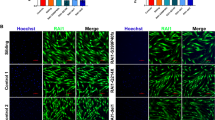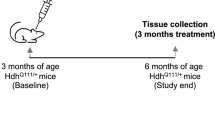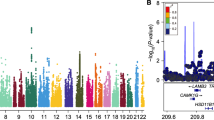Abstract
The retinoic acid induced 1 (RAI1) gene when deleted or mutated results in Smith–Magenis syndrome (SMS), while duplication of 17p11.2, including RAI1, results in the dup(17)(p11.2) syndrome characterized by mental retardation, growth and developmental delays, and hyperactivity. Mouse models for these human syndromes may help define critical roles for RAI1 in mammalian development and homeostasis that otherwise cannot be deduced from patient studies. A mouse model for duplication, Dp(11)17+, involving Rai1 has been reported. However, this mutant was engineered on a mixed genetic background confounding phenotypic effects due to possible modifier genes. We have therefore created and evaluated mice with a graded series of four (hemizygous) and six (homozygous) copies of Rai1, and overexpressing Rai1 >1.5-fold and >2-fold, respectively. Data show that Rai1-transgenic mice have growth retardation, increased locomotor activity, and abnormal anxiety-related behavior compared to wild-type littermates. Rai1-transgenic mice also have an altered gait with short strides and long sways, impaired ability on a cage-top hang test, decreased forelimb grip strength, and a dominant social behavior. Further, analyses of homozygous transgenic mice revealed a dosage-dependent exacerbation of the phenotype, including extreme growth retardation, severe neurological deficits, and increased hyperactivity. Our results show that Rai1 dosage has major consequences on molecular processes involved in growth, development, and neurological and behavioral functions, thus providing evidence for several dosage-thresholds for phenotypic manifestations causing dup(17)(p11.2) syndrome or SMS in humans.
Similar content being viewed by others
Log in or create a free account to read this content
Gain free access to this article, as well as selected content from this journal and more on nature.com
or
Accession codes
References
Girirajan S, Williams SR, Garbern JY, Nowak N, Hatchwell E, Elsea SH : 17p11.2p12 triplication and del(17)q11.2q12 in a severely affected child with dup(17)p11.2p12 syndrome. Clin Genet 2007; 72: 47–58.
Slager RE, Newton TL, Vlangos CN, Finucane B, Elsea SH : Mutations in RAI1 associated with Smith–Magenis syndrome. Nat Genet 2003; 33: 466–468.
Smith AC, McGavran L, Robinson J et al: Interstitial deletion of (17)(p11.2p11.2) in nine patients. Am J Med Genet 1986; 24: 393–414.
Girirajan S, Vlangos CN, Szomju BB et al: Genotype-phenotype correlation in Smith–Magenis syndrome: evidence that multiple genes in 17p11.2 contribute to the clinical spectrum. Genet Med 2006; 8: 417–427.
Potocki L, Bi W, Treadwell-Deering D et al: Characterization of Potocki–Lupski syndrome (dup(17)(p11.2p11.2)) and delineation of a dosage-sensitive critical interval that can convey an autism phenotype. Am J Hum Genet 2007; 80: 633–649.
Toulouse A, Rochefort D, Roussel J, Joober R, Rouleau GA : Molecular cloning and characterization of human RAI1, a gene associated with schizophrenia. Genomics 2003; 82: 162–171.
Gerber HP, Seipel K, Georgiev O et al: Transcriptional activation modulated by homopolymeric glutamine and proline stretches. Science 1994; 263: 808–811.
Aasland R, Gibson TJ, Stewart AF : The PHD finger: implications for chromatin-mediated transcriptional regulation. Trends Biochem Sci 1995; 20: 56–59.
Girirajan S, Elsas II LJ, Devriendt K, Elsea SH : RAI1 variations in Smith–Magenis syndrome patients without 17p11.2 deletions. J Med Genet 2005; 42: 820–828.
Imai Y, Suzuki Y, Matsui T, Tohyama M, Wanaka A, Takagi T : Cloning of a retinoic acid-induced gene, GT1, in the embryonal carcinoma cell line P19: neuron-specific expression in the mouse brain. Brain Res Mol Brain Res 1995; 31: 1–9.
Crawley JN, Paylor R : A proposed test battery and constellations of specific behavioral paradigms to investigate the behavioral phenotypes of transgenic and knockout mice. Horm Behav 1997; 31: 197–211.
Irwin S : Comprehensive observational assessment: Ia. A systematic, quantitative procedure for assessing the behavioral and physiologic state of the mouse. Psychopharmacologia 1968; 13: 222–257.
Rogers DC, Fisher EM, Brown SD, Peters J, Hunter AJ, Martin JE : Behavioral and functional analysis of mouse phenotype: SHIRPA, a proposed protocol for comprehensive phenotype assessment. Mamm Genome 1997; 8: 711–713.
Moser VC, McCormick JP, Creason JP, MacPhail RC : Comparison of chlordimeform and carbaryl using a functional observational battery. Fundam Appl Toxicol 1988; 11: 189–206.
Tegeris JS, Balster RL : A comparison of the acute behavioral effects of alkylbenzenes using a functional observational battery in mice. Fundam Appl Toxicol 1994; 22: 240–250.
Ballester M, Castello A, Ibanez E, Sanchez A, Folch JM : Real-time quantitative PCR-based system for determining transgene copy number in transgenic animals. Biotechniques 2004; 37: 610–613.
Mogass M, York TP, Li L, Rujirabanjerd S, Shiang R : Genomewide analysis of gene expression associated with Tcof1 in mouse neuroblastoma. Biochem Biophys Res Commun 2004; 325: 124–132.
Paylor R, Nguyen M, Crawley JN, Patrick J, Beaudet A, Orr-Urtreger A : Alpha7 nicotinic receptor subunits are not necessary for hippocampal-dependent learning or sensorimotor gating: a behavioral characterization of Acra7-deficient mice. Learn Mem 1998; 5: 302–316.
Peier AM, McIlwain KL, Kenneson A, Warren ST, Paylor R, Nelson DL : (Over)correction of FMR1 deficiency with YAC transgenics: behavioral and physical features. Hum Mol Genet 2000; 9: 1145–1159.
Reimold AM, Grusby MJ, Kosaras B et al: Chondrodysplasia and neurological abnormalities in ATF-2-deficient mice. Nature 1996; 379: 262–265.
Tourtellotte WG, Milbrandt J : Sensory ataxia and muscle spindle agenesis in mice lacking the transcription factor Egr3. Nat Genet 1998; 20: 87–91.
Lijam N, Paylor R, McDonald MP et al: Social interaction and sensorimotor gating abnormalities in mice lacking Dvl1. Cell 1997; 90: 895–905.
Shimano H : Sterol regulatory element-binding proteins (SREBPs): transcriptional regulators of lipid synthetic genes. Prog Lipid Res 2001; 40: 439–452.
Chrast R, Scott HS, Madani R et al: Mice trisomic for a bacterial artificial chromosome with the single-minded 2 gene (Sim2) show phenotypes similar to some of those present in the partial trisomy 16 mouse models of Down syndrome. Hum Mol Genet 2000; 9: 1853–1864.
Yang XW, Wynder C, Doughty ML, Heintz N : BAC-mediated gene-dosage analysis reveals a role for Zipro1 (Ru49/Zfp38) in progenitor cell proliferation in cerebellum and skin. Nat Genet 1999; 22: 327–335.
Funke B, Epstein JA, Kochilas LK et al: Mice overexpressing genes from the 22q11 region deleted in velo-cardio-facial syndrome/DiGeorge syndrome have middle and inner ear defects. Hum Mol Genet 2001; 10: 2549–2556.
Roper RJ, Reeves RH : Understanding the basis for Down syndrome phenotypes. PLoS Genet 2006; 2: e50.
Bi W, Yan J, Stankiewicz P et al: Genes in a refined Smith–Magenis syndrome critical deletion interval on chromosome 17p11.2 and the syntenic region of the mouse. Genome Res 2002; 12: 713–728.
Walz K, Paylor R, Yan J, Bi W, Lupski JR : Rai1 duplication causes physical and behavioral phenotypes in a mouse model of dup(17)(p11.2p11.2). J Clin Invest 2006; 116: 3035–3041.
Bi W, Ohyama T, Nakamura H et al: Inactivation of Rai1 in mice recapitulates phenotypes observed in chromosome engineered mouse models for Smith–Magenis syndrome. Hum Mol Genet 2005; 14: 983–995.
Walz K, Caratini-Rivera S, Bi W et al: Modeling del(17)(p11.2p11.2) and dup(17)(p11.2p11.2) contiguous gene syndromes by chromosome engineering in mice: phenotypic consequences of gene dosage imbalance. Mol Cell Biol 2003; 23: 3646–3655.
Walz K, Spencer C, Kaasik K, Lee CC, Lupski JR, Paylor R : Behavioral characterization of mouse models for Smith–Magenis syndrome and dup(17)(p11.2p11.2). Hum Mol Genet 2004; 13: 367–378.
Bi W, Yan J, Shi X et al: Rai1 deficiency in mice causes learning impairment and motor dysfunction, whereas Rai1 heterozygous mice display minimal behavioral phenotypes. Hum Mol Genet 2007; 16: 1802–1813.
Yan J, Keener VW, Bi W et al: Reduced penetrance of craniofacial anomalies as a function of deletion size and genetic background in a chromosome engineered partial mouse model for Smith–Magenis syndrome. Hum Mol Genet 2004; 13: 2613–2624.
Balthasar N : Genetic dissection of neuronal pathways controlling energy homeostasis. Obesity (Silver Spring) 2006; 14 (Suppl 5): 222S–227S.
Accili D, Fishburn CS, Drago J et al: A targeted mutation of the D3 dopamine receptor gene is associated with hyperactivity in mice. Proc Natl Acad Sci USA 1996; 93: 1945–1949.
Kelly MA, Rubinstein M, Phillips TJ et al: Locomotor activity in D2 dopamine receptor-deficient mice is determined by gene dosage, genetic background, and developmental adaptations. J Neurosci 1998; 18: 3470–3479.
Dere E, De Souza-Silva MA, Frisch C et al: Connexin30-deficient mice show increased emotionality and decreased rearing activity in the open-field along with neurochemical changes. Eur J Neurosci 2003; 18: 629–638.
Barinaga M : The cerebellum: movement coordinator or much more? Science 1996; 272: 482–483.
D'Hooge R, Hartmann D, Manil J, Colin F, Gieselmann V, De Deyn PP : Neuromotor alterations and cerebellar deficits in aged arylsulfatase A-deficient transgenic mice. Neurosci Lett 1999; 273: 93–96.
Hemsley KM, Hopwood JJ : Development of motor deficits in a murine model of mucopolysaccharidosis type IIIA (MPS-IIIA). Behav Brain Res 2005; 158: 191–199.
Costa AC, Walsh K, Davisson MT : Motor dysfunction in a mouse model for Down syndrome. Physiol Behav 1999; 68: 211–220.
Glynn D, Drew CJ, Reim K, Brose N, Morton AJ : Profound ataxia in complexin I knockout mice masks a complex phenotype that includes exploratory and habituation deficits. Hum Mol Genet 2005; 14: 2369–2385.
Ameye LG, Young MF : Animal models of osteoarthritis: lessons learned while seeking the ‘Holy Grail’. Curr Opin Rheumatol 2006; 18: 537–547.
Lin X, Cummings CJ, Zoghbi HY : Expanding our understanding of polyglutamine diseases through mouse models. Neuron 1999; 24: 499–502.
Hayes S, Turecki G, Brisebois K et al: CAG repeat length in RAI1 is associated with age at onset variability in spinocerebellar ataxia type 2 (SCA2). Hum Mol Genet 2000; 9: 1753–1758.
Zhang Z, Baldini A : In vivo response to high-resolution variation of Tbx1 mRNA dosage. Hum Mol Genet 2008; 17: 150–157.
Acknowledgements
We acknowledge Dr Mario Dance at Virginia Commonwealth University for helping with collection of blood samples and care of mice, Dr Thom Saunders and Elizabeth Hughes from the University of Michigan Transgenic Animal Core, Catherine Barth and Tiffany Newton for preliminary mouse evaluations, and Dr Michael Grotewiel, Dr Christopher Vlangos, Stephen Williams, and Lily Hoa Truong for critical reading of the manuscript. We thank the histopathology core at the Michigan State University and the Comparative Pathology Lab at UC Davis for mouse tissue and serum studies. This work was supported, in part, by NIH R01 HD38534 and by resources from Michigan State University and Virginia Commonwealth University.
Author information
Authors and Affiliations
Corresponding author
Additional information
Conflict of interest
The authors declare no conflict of interest.
Supplementary Information accompanies the paper on European Journal of Human Genetics website (http://www.nature.com/ejhg)
Supplementary information
Rights and permissions
About this article
Cite this article
Girirajan, S., Patel, N., Slager, R. et al. How much is too much? Phenotypic consequences of Rai1 overexpression in mice. Eur J Hum Genet 16, 941–954 (2008). https://doi.org/10.1038/ejhg.2008.21
Received:
Revised:
Accepted:
Published:
Issue date:
DOI: https://doi.org/10.1038/ejhg.2008.21
Keywords
This article is cited by
-
Velusetrag rescues GI dysfunction, gut inflammation and dysbiosis in a mouse model of Parkinson’s disease
npj Parkinson's Disease (2023)
-
Thermo-sensitive electroactive hydrogel combined with electrical stimulation for repair of spinal cord injury
Journal of Nanobiotechnology (2021)
-
Neuromodulation of the cerebellum rescues movement in a mouse model of ataxia
Nature Communications (2021)
-
Composite Sleep Problems Observed Across Smith–Magenis Syndrome, MBD5-Associated Neurodevelopmental Disorder, Pitt–Hopkins Syndrome, and ASD
Journal of Autism and Developmental Disorders (2021)
-
Motor skills mediated through cerebellothalamic tracts projecting to the central lateral nucleus
Molecular Brain (2019)



